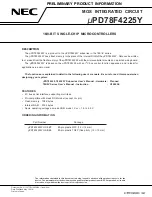
Instruction Manual
D100333X012
1069 Actuator
April 2018
9
Disassembly
The following procedure describes how to disassemble the actuator for inspection and replacement of parts. When
performing this procedure, disassemble only those parts necessary to accomplish the job.
1. Bypass the control valve, reduce loading pressure to atmospheric, and then remove the tubing or piping from both
actuator cylinders.
2. Remove the positioner, if one is used.
3. Remove the cap screws and washers (keys 25 and 38) and then remove the cover (key 24). If a manual operator is
used, it is removed with the cover.
4. Remove the inner retaining ring (key 22) and slide the hub (key 21) from the cover (key 24). If a manual operator is
used, refer to the manual operator section for disassembly instructions.
5. Check the condition of the bearing (key 23). If replacement of the bearing is necessary, remove the self‐tapping
screws and travel indicator scale (keys 27 and 26) before replacing the bearing.
6. Remove the cap screws and anti‐rotator assemblies (keys 8 and 42).
7. Note the lever/valve shaft orientation. Then loosen the cap screws (key 20) and rotate the set screw (key 41)
clockwise slightly to spread the split portion of the lever (key 19). Remove the lever through the openings in the
housing (key 15). For an 8510 valve body, the disk must be open approximately 20 degrees to allow enough
clearance for lever removal. For a V250 valve body, the ball must be open approximately 70 degrees to allow
enough clearance for lever removal. Consult the valve body instruction manual for assistance during this step.
CAUTION
Do not use a hammer or similar tool to drive the lever (key 19) off the valve shaft. Driving the lever could damage internal
valves parts. On some valve types, driving the lever could move the valve disk and bearings away from the centered
position, causing subsequent damage to valve parts as the valve is being operated.
If necessary, use a wheel puller to remove the lever. It is okay to tap the wheel puller screw lightly to loosen the lever, but
hitting the screw with excessive force could also damage valve parts or disrupt the centered position of the valve disk and
bearings.
8. Remove both rod end bearings (key 7).
9. Unscrew the cap screws (key 16) and remove both cylinder flanges (key 2) with attached cylinder assemblies (key
1). Then remove both sliding seals (key 13), both thrust washers (key 36), and both seal support cylinders (key 14).
10. Remove the cap screws (key 3) and separate each cylinder flange from each cylinder assembly.
11. Pull each piston rod (key 6) with attached piston (key 4) out of each respective cylinder assembly.
12. Check and, if necessary, replace the O‐rings (keys 5 and 10). For ease of assembly, lubricate the O‐rings with lithium
grease if they are removed.
13. To separate each piston and piston rod, unscrew the hex nut (key 43). Check both piston rods for nicks and
scratches that could disrupt the sealing surfaces of the sliding seals and O‐rings (keys 13 and 11). Replace either
piston rod if necessary.
14. Inspect and, if necessary, replace the O‐rings (keys 11 and 12) and both thrust washers (key 36). For ease of
assembly, lubricate the O‐rings with lithium grease if they are removed.
15. Unscrew the cap screws (key 18) and remove the housing.
16. Unbolt the mounting yoke (key 17) from the valve body. Then, slide the mounting yoke off the valve shaft.
17. Check the bearing (key 40). Press out and replace the bearing if necessary.
18. Refer to the assembly procedure for replacement of parts.


































